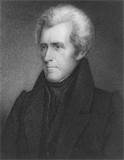The Nullification Crisis was a dispute between federal and state governments that had its roots in the founding of the country. The tradition of a strong state government went right back to colonial days. The 13 Colonies had banded together to declare themselves independent from Great Britain and then stood together to fight a war to maintain that independence, but each of the 13 Colonies had its distinct character, economic needs, and philosophies. This individuality was offset in part by regional similarities and by the Constitution, which created a stronger central government than the one that had existed under the Articles of Confederation. But the colonies-turned-states still possessed a strong sense of state identity.
One of the main avenues of revenue generation in early America was the tariff, a tax on goods transferred from one entity to another. Transactions could take place between companies, between states, or between countries. The Tariff of 1828 was deeply unpopular in parts of New England and the South and was so detrimental to South Carolina, in particular, that that state began to agitate for a political response. South Carolina's own John C. Calhoun was Vice-president at the time, having been elected with Andrew Jackson (right) in 1828. The common epithet given to this unpopular tax was the "Tariff of Abominations." Because of a post-War of 1812 economic downturn, several states, including South Carolina, were suffering. The new nation had suffered its first financial crisis, called the Panic of 1819; and South Carolina had not really recovered. 
Calhoun (right), originally a proponent of ideas espoused by the Whig Party's American System, had supported, then opposed a couple of earlier tariffs, passed in 1816 and 1824. (The first one placed a 25-percent tax on a host of goods; the 1824 tariff raised that figure to 35 percent. Among the goods heavily taxed were cotton, hemp, iron, and wool.) Neither tariff passed Congress with anything approaching an overwhelming majority. Both tariffs, and the 1828 one, did find a majority to approve it, along with a presidential signature, and so they became the law of the land. Virginia in 1826 passed a resolution in the state legislature, asserting that the tariffs were unconstitutional and using the Virginia and Kentucky Resolutions as justification. Even though the 1828 tariff was an "abomination" in equal parts Northeast and South, depending on which state the poll would have been taking, it was the Southern states that were generally more seriously affected and one Southern state, South Carolina, that did something legislative about it. 
Southerners had lined up in opposition to the Tariff of 1828 and had thought that the newly elected Jackson, from the South, would get to work dismantling the tariff. He did no such thing, even at great urging from Calhoun, his Vice-president. As the state economy continued to struggle, the mood in South Carolina continued to sour and many began to call for nullification. Calhoun felt so strongly about the issue that he resigned as Vice-president (one of only two ever to do so) in order to serve in the Senate, where he thought he could more effectively take up the nullification cause. (He filled the seat of Robert Hayne, who had resigned in order to run for Governor.) Calhoun had earlier written and gotten circulated South Carolina Exposition and Protest, a tract laying out the justification for nullification. In the meantime, Jackson and Congress had come up with a weakened tariff that most of the other states who had termed the 1828 tariff an "abomination" were more in favor of. On July 14, 1832, President Jackson signed into law the Tariff of 1832. Most Northerners and half of Southerners in Congress voiced their approval. Calhoun and the South Carolina delegation did not. A November state convention passed a resolution declaring both the 1828 and 1832 tariffs unconstitutional and unenforceable within the state borders of South Carolina beginning on February 1, 1833. President Jackson responded on two fronts, advocating the use of military force to bring South Carolina into line while also convincing Congress to work on yet another tariff, one that South Carolina might finally approve. Congress passed both a Force Bill and the Compromise Tariff of 1833 (negotiated by the Great Compromiser himself, Henry Clay). South Carolina responded by repealing its nullification ordinance. In a sense, both Jackson and South Carolina could claim victory. The new tariff was weak enough to gain the support of the recalcitrant South Carolina and the rest of the South, so state agitation was effectively at an end. South Carolina got what it wanted, and so did the Federal Government. Both sides avoided a military showdown (although Jackson might have helped convince South Carolina of the futility of this by sending a couple of Navy ships to Charleston). The idea of a state's being able to step outside the jurisdiction of the Federal Government didn't go away, however; that idea lay simmering on the back burner and heated up again, especially in South Carolina, a few decades later, in a series of irreconcilable differences that led to the Civil War. |
|
Social Studies for Kids
copyright 2002–2025
David White



 This idea was very much in line with the thinking of the leaders of the
This idea was very much in line with the thinking of the leaders of the 
